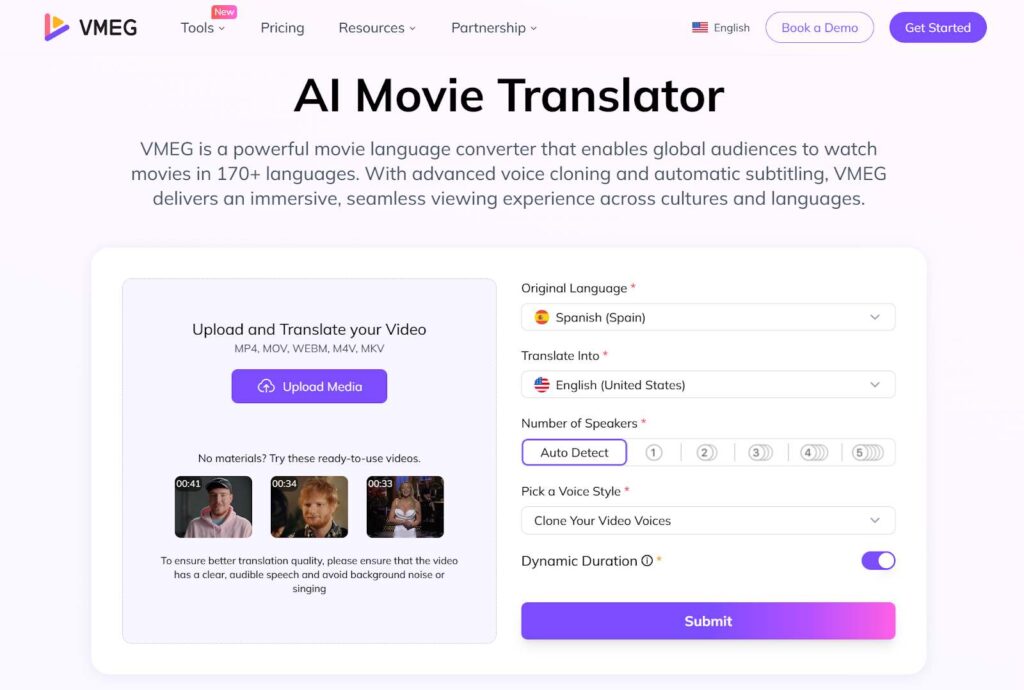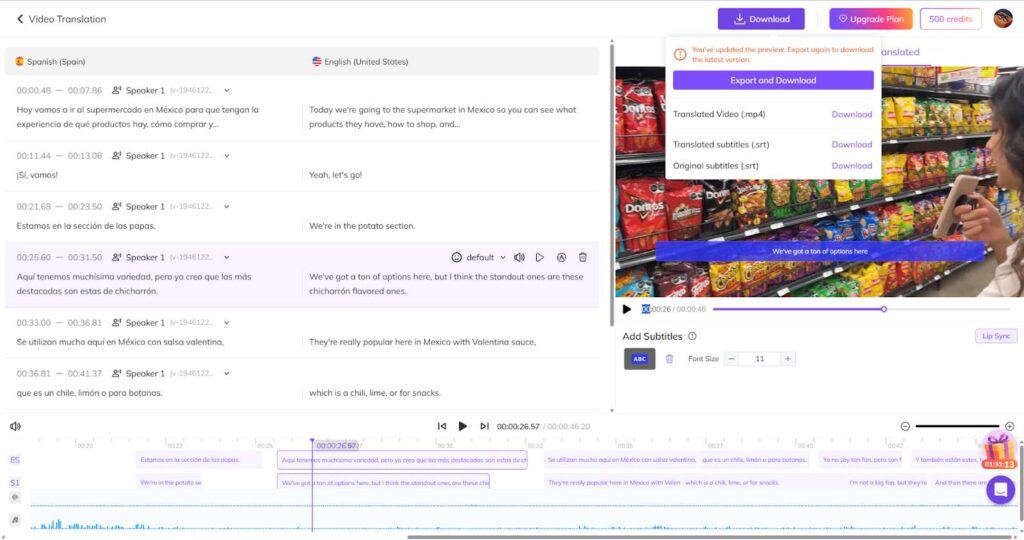The global film industry has experienced remarkable growth and is projected to increase from $100.38 billion in 2023 to $169.68 billion by 2030, expanding at an 8.1% compound annual growth rate (grandviewresearch, 2025). But language has been the major challenge. Hollywood films dominate international markets, and non-English films often struggle to gain global reach due to the high costs and long timelines.
Enter VMEG AI, an AI-powered platform that is changing the way movies are localized and translated for international audiences. In this article, we’ll explore how VMEG AI makes movie translation faster, more affordable, and, perhaps most impressively, more authentic.
Why Movie Translation Matters
Movie translation makes films accessible to a global audience, and the global video localization market is booming. Multilingual content is the trend to keep up with the growing demand worldwide.
Movie translation enhances video accessibility to reach a wider audience. Studies show that localized films generate 340% higher revenue in international markets compared to subtitled versions. Dubbing also breaks literacy barriers, making content accessible to children, the elderly, and those with reading difficulties.
For example, the success of films like Coco and Frozen highlights the importance of cultural authenticity in movie localization. Frozen became a global hit partly because of the culturally appropriate voice casting and localized songs in different regions.
How VMEG AI Meets the Demands of Movie Localization
VMEG uses advanced AI technology to provide a faster, more cost-effective, and high-quality solution for video localization. For movie translation, it employs innovative voice cloning and intelligent algorithms to ensure translations sound natural and true to the original.
VMEG’s professional movie translator can analyze vocal characteristics, including pitch, tone, pacing, and emotional nuance, then create a synthetic voice that mirrors the original actor’s voice in a different language.
VMEG AI Key Features for Movie Localization
- Multilingual Language Support: VMEG translates movies in 170+ languages for global audiences. It delivers a natural-sounding and seamless viewing experience across cultures and languages.
- Advanced Voice Cloning: VMEG’s VoiceClone 3.0 technology goes beyond basic voice replication, preserving emotional delivery, whether the scene is intense or comedic. This ensures dramatic moments carry the same impact, and humor translates just as effectively.
- Intelligent Lip-Sync Optimization: A common issue with dubbed films is poor lip-syncing. VMEG uses computer vision technology to match the translated speech with the actor’s lip movements, creating a more seamless viewing experience.
- Character Voice Consistency: In feature films, it’s important to maintain the same voice for a character throughout the entire movie. VMEG AI’s Character Voice Memory system ensures that each character’s voice remains consistent, no matter the scene.
- Multi-Track Audio Processing: VMEG separates dialogue from background music and sound effects, translating only the spoken content while keeping the original audio atmosphere intact. This precision helps preserve the emotional impact of the film.
Pros and Cons of VMEG AI
Benefits
- Speed: Traditional dubbing can take 6-8 weeks, but VMEG AI can translate a full-length film in just 24-48 hours. This means films can be released worldwide on the same day as the original.
- Cost Savings: Credits-based pricing plans include a free version to try, small business and enterprise plans. Independent filmmakers can save a lot compared to traditional dubbing.
- Voice Authenticity: Users say the AI-generated voices are virtually indistinguishable from human voice actors, especially in animated content.
Limitations
- Cultural Context: Some cultural nuances and idioms may not translate perfectly, requiring manual adjustments in certain cases.
- Technical Limitations: Overlapping dialogue or heavily accented speech can sometimes lead to misidentification of speakers, necessitating corrections.
Use Cases of VMEG AI Movie Localization
Independent Filmmakers
Independent filmmakers can now afford to localize their films into multiple languages, making it possible for their work to compete on the international stage.
Film Festivals
With the cost of traditional dubbing prohibitive, film festivals can use AI-dubbed or subtitled technology, allowing films from around the world to compete on a level playing field.
Animated Content
Animation, especially cartoon voices, translates exceptionally well through AI dubbing, often surpassing the quality of human dubbing. Animator has successfully used AI for animated films, achieving a mass of audience satisfaction.
Short Films
VMEG provides faster movie translation than ever, especially for short films, processing tasks with accurate results for quick production, like demonstration.
How to Translate a Movie Using VMEG AI
The system processes video content through a multi-step pipeline that extracts audio, transcribes it, and then translates it using machine learning models optimized for conversational dialogue.
Steps to Use VMEG AI for Translation
Step 1. Upload a File
Go to the VEMG AI Movie Translator landing page, sign in to your account, and then select a movie file to upload.
Step 2. Choose Languages and Translation Settings
Select the original language, target language, number of speakers, and pick a voice style like clone your video voices or auto match system voices. Tap on Submit to continue.

Step 3. Translate the Movie and Download
Wait for minutes and you will get the translated movie. Here you can check the results, add subtitles with customizable styles, enable lip-sync, and more. Then download the translated movie with embedded subtitles.

Frequently Asked Questions about VMEG AI Movie Translation
Can VMEG AI-dubbed voices truly sound authentic to the original?
Yes, VMEG AI emphasizes voice authenticity. It leverages advanced voice cloning technology to replicate not only the voice but also the actor’s emotional performance. This results in translations that sound natural and remain faithful to the original, preserving emotional depth across languages.
Can I translate films into multiple languages while maintaining cultural elements?
Yes, VMEG AI supports over 170 languages, allowing accurate translations for global audiences. It ensures cultural authenticity by adapting dialogues and tone for each region. However, for certain complex cultural nuances or idioms, manual adjustments might be necessary to achieve optimal results, but VMEG AI strives to uphold each film’s cultural integrity.
How can I fix the issue of unnatural lip-syncing?
Movie translators like VMEG AI use intelligent computer vision technology to analyze actors’ lip movements frame-by-frame. The system then fine-tunes the timing and rhythm of the translated speech to match these lip movements precisely, creating a much more natural viewing experience in the dubbed language.
Conclusion
As the global film industry continues to expand, overcoming language barriers has become crucial for reaching wider international audiences. VMEG AI offers a solution to make movie translation faster and more affordable. With advanced tools like voice cloning, intelligent algorithms, and multi-track audio processing, VMEG ensures that films remain accessible worldwide with their original emotional depth and cultural authenticity.






